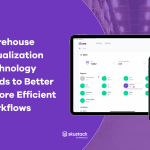
Key Points
- The top WMS trends of 2025 include AI and machine learning, Warehouse Execution Systems (WES), micro-fulfillment and omnichannel distribution, 5G and Edge Computing, mobile devices, sustainable practices, WMS flexibility, and warehouse visualization.
- Using a WMS allows businesses to digitalize their operations, set efficiency targets, trace inventory, and forecast demand.
- Some of the different types of WMS include a standalone WMS platform, cloud-based, and bolt-on. A WMS can also come in the form of a Supply Chain Module (SCM) or Enterprise Resource Planning (ERP) module.
- Descartes Sellercloud’s Skustack WMS module is a powerful warehouse management system with advanced features and Descartes Peoplevox is excellent option for high growth direct-to-consumer (D2C) brands.
Warehouse management systems (WMS) are a vital cornerstone of ecommerce logistics. They help online sellers get products out of the warehouse and to customers’ homes in the best possible way and are crucial when handling large volumes of products. Like many other technologies we rely on in ecommerce, WMS constantly changes with the arrival of new tech and evolving customer demands.
Yes, trends do come and go, but you don’t want to get left behind by your competitors. While some trends might not last, some are here to stay for the long run. You don’t want to be playing catch-up when you could be ahead of the crowd. Even if you decide not to follow some of these trends, being aware of them is better than living in the dark.
This article will examine the biggest WMS trends for 2025 and how online sellers can keep up with them.
10 Warehouse Management System Trends for 2025
Most WMS trends are driven by one thing, ‘efficiency.’ Everyone’s looking for ways to speed up their operations, cut dead weight, lower expenses, and reduce mistakes. These are the ten most important WMS trends to focus on for 2025. Below, we have explained what they mean for online sellers and how to align with each trend.

1. Artificial Intelligence and Machine Continue to Play a Major Role
Artificial intelligence (AI) and machine learning (ML) will improve efficiency by automating processes, recognizing patterns, and predicting outcomes.
What this means: Automating tasks will free up time, uncovering unique patterns will provide insights into warehouse operations, and predictions can optimize warehouse processes. Nowadays, AI is used in many business areas, like forecasting customer demand, optimizing stock levels, and automating order completion.
Meanwhile, machine learning can be invaluable in recognizing customer patterns and trends, which can help companies place products more effectively within the warehouse.
How to prepare: To stay ahead, ecommerce businesses should make the most out of AI and ML tools and ensure their WMS is compatible.
2. More Robots and More Automation
Robotics and automation will continue to be a staple in the industry, reducing labor costs and increasing accuracy for warehouse tasks.
What this means: Robots can increase accuracy by picking, packing, and sorting orders, while automated sorters can sort and route packages, reducing dependence on manual labor. Theoretically, this should also enable businesses to reduce lead times and improve customer satisfaction.
This trend is still relatively young, of course. According to a report by Business Wire, over 80% of warehouses still don’t use automation. However, it added that in the last decade, around 15% of warehouses were in the process of being mechanized, and up to 5% already were.
How to prepare: Consider investing in robotics and automation technology and ensure that WMS can integrate with these tools.
3. ‘Warehouse Execution Systems’ Are Supercharging Efficiency
Warehouse execution systems (WES) are becoming critical for ecommerce warehouses as they bridge the gap between warehouse management systems (WMS) and warehouse control systems (WCS).
What this means: A WES coordinates real-time activities, managing resources, workflows, and equipment simultaneously to optimize warehouse operations. It allows for better decision-making by integrating inventory management, labor management, and automation tools. By providing a holistic view of warehouse activities, a WES enhances productivity, reduces costs, and ensures smoother operations.
How to prepare: Evaluate if your warehouse operations are complex enough to require a WES and consider solutions that seamlessly integrate with your existing WMS and automation equipment.
Learn more about WES and WCS and how they related to warehouse management here.
4. The Internet of Things is Here to Stay
The Internet of Things (IoT) has proven that it can make an enormous difference in the efficiency of ecommerce operations.
What this means: With the advent of IoT, ecommerce firms can now keep tabs on their inventory, staff, and assets in real-time. IoT helps business owners better understand what is happening in their warehouses, streamline operations, cut unnecessary costs, and ensure customer satisfaction.
Many IoT devices use sensors to monitor a product’s location and condition. Meanwhile, wearable tech can help keep tabs on warehouse personnel’s whereabouts and work activity. According to estimates from Statista, by 2025, up to 30.9 billion devices will be connected to the IoT, an enormous increase from 0.8 billion in 2010.
How to prepare: Consider how IoT-enabled devices may benefit your warehouse operations.
5. Micro-Fulfillment and Omnichannel Distribution Are Helping Deliver Faster
Micro-fulfillment centers and omnichannel distribution are increasingly becoming necessary for ecommerce businesses looking to provide faster delivery and enhance customer satisfaction.
What this means: Micro-fulfillment involves smaller, strategically located warehouses close to major population centers, enabling quicker delivery and lower transportation costs. Paired with omnichannel distribution, companies can fulfill orders through multiple channels—including retail stores, warehouses, and third-party logistics providers—more efficiently. This trend helps businesses compete with larger retailers by reducing last-mile delivery costs and times.
How to prepare: Determine if a micro-fulfillment strategy aligns with your business objectives. Invest in flexible WMS solutions capable of supporting multiple fulfillment channels seamlessly.
6. 5G and Edge Computing Are Transforming Warehouse Operations
The adoption of 5G networks and edge computing is revolutionizing ecommerce warehouses by drastically improving connectivity, reducing latency, and enhancing real-time decision-making.
What this means: 5G and edge computing enable warehouses to process data faster, allowing for real-time analytics and immediate action. This technology supports advanced automation, robotics, augmented reality (AR) applications, and autonomous guided vehicles (AGVs), making warehouse operations faster and more responsive.
How to prepare: Begin assessing your warehouse’s readiness for 5G integration. Work with your tech providers to ensure your WMS is compatible and able to leverage the capabilities of 5G and edge computing.
7. Mobile Devices Will be Leveraged More
Smartphones and tablets will continue to be integrated into WMS, improving real-time tracking, communication, and data analysis.
What this means: Integrating mobile devices will enable warehouse personnel to access data and communicate from anywhere in the warehouse, improving efficiency and reducing errors. The most obvious example is utilizing barcode scanning apps that can scan products and update inventory records. Other reasons to use mobile devices include:
- Managing the inventory from the warehouse floor.
- Overcoming network issues.
- Enabling staff to make informed decisions.
How to prepare: To prepare for this trend, ecommerce businesses should ensure they can integrate mobile devices with their WMS.
8. You Can No Longer Afford to Miss Out on Sustainability
Warehouse management systems need to prioritize sustainability, with a better focus on energy efficiency, waste reduction, and eco-friendly practices.
What this means: Ecommerce businesses will be under increasing pressure to reduce their environmental footprint and adopt sustainable practices throughout their supply chain. Companies that use WMS solutions that optimize inventory levels to reduce waste and minimize the use of fossil fuels in transportation will become preferable to customers.
Many supply chain companies are already ahead on this trend. Business Wire reported in 2020 that 81% of companies were more focused on sustainability than three years ago. The report noted that supply chain management was a key area where changes were needed to achieve sustainability.
How to prepare: Ecommerce businesses should adopt sustainable practices throughout their supply chain and consider cutting processes that are not environmentally friendly.
9. Your WMS Needs to be More Flexible
Customer demand for faster and more accurate order fulfillment is driving the need for more flexible WMS solutions.
What this means: This will require ecommerce businesses to adopt WMS solutions that can handle high-volume orders and adapt to changing business and customer needs. For example, WMS solutions that dynamically allocate inventory based on demand will become increasingly important.
How to prepare: Ensure your WMS can handle high volumes of orders and is flexible enough to adapt to changing customer needs.
10. Warehouse Visualization Is a Must
It is now a necessity for warehouse management systems to provide sellers with a bird’s-eye view of the products stored in warehouses and their pathways.
What this means: Warehouse visualization will open your eyes to how products are moving around your warehouse and can help you find the optimal places to store them. For example, if a product leaves shelves regularly and quickly, it may be better to store it towards the front of the warehouse instead of the back.
Similarly, you may have difficult-to-store products that could be better located, and there may also be areas that would be better to keep free to move products around. Most importantly, you can see where every product and employee is at any given time and watch every inch of the warehouse from the comfort of the office.
How to prepare: Ensure your next WMS comes with warehouse visualization features to monitor how your products move about the warehouse.
What are the Benefits of a Warehouse Management System?

For those with no clue where to start with WMS, let’s quickly break down why it’s so crucial for online sellers.
- Digitalize your operations. This comes with a host of benefits, but the best is better visibility of your operations and the ability to integrate with other useful systems.
- Set efficiency targets. With a clearer view of your warehouse, you may uncover inefficiencies you didn’t know existed and create a plan to put a stop to them.
- Trace your inventory. It will be easier to track your inventory across your warehouse, reducing the chances of stock disappearing or ending up in the wrong place.
- Forecast demand. With a better understanding of what’s coming in and out of your warehouse, you’ll more accurately order products based on their demand.
However, on the flip side, as we’ve noted with many of 2025’s WMS trends, there are plenty of things you consider when using a WMS. The most significant consideration to take into account is that you will have to upskill your staff to use this new tech, or you may need to hire more technically-minded staff.
What Are the Different Types of Warehouse Management System?
Not all warehouse management systems are the same. In fact, there are five primary types of warehouse management systems you should know about before making any decisions.
1. Standalone (Basic)
Standalone warehouse management systems are the most basic you could ask for. This is an excellent place to start if you are a small business looking to simplify your warehouse management. While you can deal with most warehouse-related tasks well with a basic standalone WMS, you may need something more sophisticated as your company grows.
Larger companies with more complex warehouse operations will need something more advanced.
2. Cloud-based
As we explained earlier, cloud-based WMS is growing, and we may eventually see it become the industry standard, and older, non-cloud-based systems may soon be phased out. To start, cloud-based WMS are easier to maintain, typically cheaper to use, and will save you a ton of storage space (say goodbye to your server!). Additional benefits can include tighter security and better user experience.
3. Bolt-on
As the name ‘bolt-on’ suggests, this type of warehouse management system is like an extra feature you add to your current warehouse operations. Bolt-on WMS work with existing solutions and doesn’t require a company to change its systems and the way they do things, such as moving to the cloud.
Companies can continue their operations as they always have and add additional layers of functionalities as they wish without interrupting their flow. Bolt-on solutions are best suited for companies that want to limit the number of changes they’ll have to implement.
4. Supply Chain Module (SCM)
A supply chain module is similar to a standalone WMS but usually offers an array of more advanced features that warehouses can benefit from. The most beneficial is the ability to automate inventory and warehouse management, and SCM is arguably better suited to companies that want to monitor their entire supply chain operations. One drawback could be that your SCM may offer features already covered by other software your company uses, and it may feel like a wasteful investment.
5. Enterprise Resource Planning (ERP) Module
An ERP offers a lot more than just WMS. These platforms often include features that assist with accounting, customer services, and even human resources. Essentially, an ERP can be used to run an entire ecommerce business. Naturally, such an option is better suited for a larger organization. However, deciding to run an entire business on one system can be a giant leap.
Learn more about the relationship between ERPs and WMS platforms here.
What’s the Best Warehouse Management System?
Predictably, there’s a lot to consider when shopping around for a good WMS. Taking 2025’s warehouse management system trends into account, here’s a quick checklist of what to look for:
- Easy to use. It shouldn’t be a massive learning curve for your employees to learn how to use a new WMS.
- Easy to integrate with your other warehouse tech. Undoubtedly, you will use other tools in your warehouse, and your new WMS should work seamlessly with them.
- It is updated regularly. A new WMS is useless if it becomes outdated quickly. You don’t want to be considering a new solution for at least several years.
- Sustainable. Ideally, the warehouse management system you choose shouldn’t waste resources.
- Valuable data collection and analysis. The data your WMS collects should provide you with actionable insights that can help you improve your operations.
- Flexibility. Particularly when it comes to changing customer demands and dealing with warehouse crises.
- Accessible everywhere (e.g., mobile devices). Accessing a WMS through a mobile device instead of a desktop will save employees a lot of back and forth.
- Cloud-based. With the benefits cloud-based warehouse management solutions have, there’s practically no reason not to use them.
- Task automation. The fewer manual tasks you have, the more time you will have for important tasks.
- Warehouse visualization. Improve how products are located and transported around the warehouse by viewing them from above.
- Accountability and traceability. Monitor your employees’ performance and retrace mistakes.
- Reporting. Receive practical reports on the products stored in your warehouse to identify and investigate any discrepancies.
If these are all things you can’t miss out on, then Descartes Sellercloud’s Skustack WMS module is your best option for a powerful warehouse management system with the most advanced features. You can also look at Skustack Lens to improve employee visibility on the ground of your warehouse and Skustack Admin to manage devices, workflow, and monitor employee activity.
Elsewhere, Descartes Peoplevox is excellent WMS option for high growth direct-to-consumer (D2C) brands.
Schedule a Descartes Sellercloud demo today to discover how our solution can eradicate your warehouse management challenges and boost growth.




